engine MITSUBISHI COLT 2011 (in English) Repair Manual
[x] Cancel search | Manufacturer: MITSUBISHI, Model Year: 2011, Model line: COLT, Model: MITSUBISHI COLT 2011Pages: 274, PDF Size: 17.88 MB
Page 213 of 274
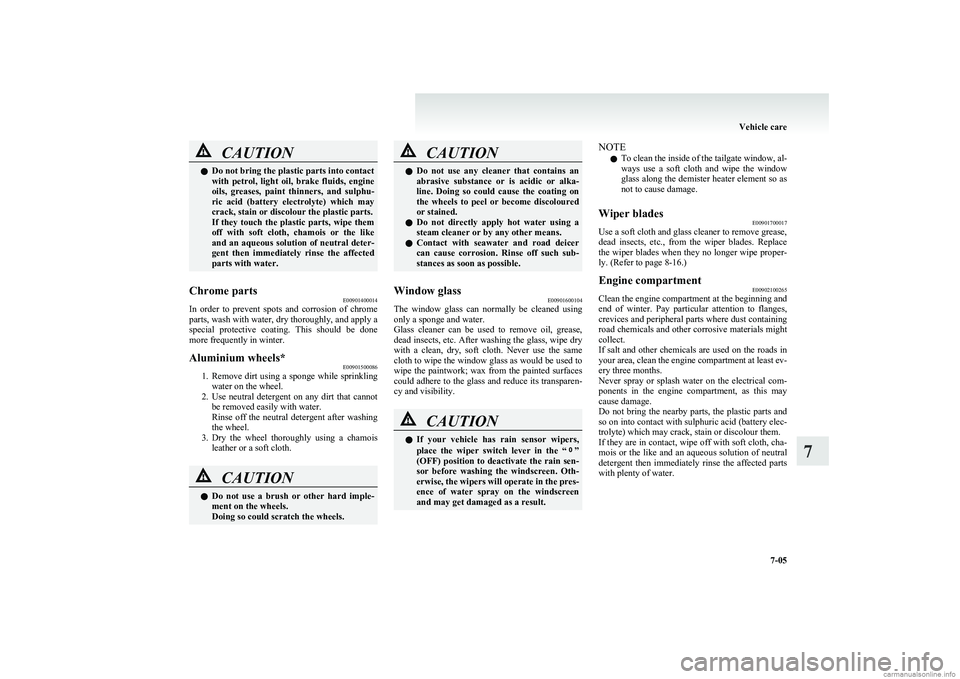
CAUTIONlDo not bring the plastic parts into contact
with petrol, light oil, brake fluids, engine
oils, greases, paint thinners, and sulphu-
ric acid (battery electrolyte) which may
crack, stain or discolour the plastic parts.
If they touch the plastic parts, wipe them
off with soft cloth, chamois or the like
and an aqueous solution of neutral deter-
gent then immediately rinse the affected
parts with water.Chrome parts E00901400014
In order to prevent spots and corrosion of chrome
parts, wash with water, dry thoroughly, and apply a
special protective coating. This should be done
more frequently in winter.
Aluminium wheels* E00901500086
1.Remove dirt using a sponge while sprinkling
water on the wheel.
2. Use neutral detergent on any dirt that cannot
be removed easily with water.
Rinse off the neutral detergent after washing
the wheel.
3. Dry the wheel thoroughly using a chamois
leather or a soft cloth.
CAUTIONl Do not use a brush or other hard imple-
ment on the wheels.
Doing so could scratch the wheels.CAUTIONl Do not use any cleaner that contains an
abrasive substance or is acidic or alka-
line. Doing so could cause the coating on
the wheels to peel or become discoloured
or stained.
l Do not directly apply hot water using a
steam cleaner or by any other means.
l Contact with seawater and road deicer
can cause corrosion. Rinse off such sub-
stances as soon as possible.Window glass E00901600104
The window glass can normally be cleaned using
only a sponge and water.
Glass cleaner can be used to remove oil, grease,
dead insects, etc. After washing the glass, wipe dry
with a clean, dry, soft cloth. Never use the same
cloth to wipe the window glass as would be used to
wipe the paintwork; wax from the painted surfaces
could adhere to the glass and reduce its transparen-
cy and visibility.
CAUTIONl If your vehicle has rain sensor wipers,
place the wiper switch lever in the “”
(OFF) position to deactivate the rain sen-
sor before washing the windscreen. Oth-
erwise, the wipers will operate in the pres-
ence of water spray on the windscreen
and may get damaged as a result.NOTE
l To clean the inside of the tailgate window, al-
ways use a soft cloth and wipe the window
glass along the demister heater element so as
not to cause damage.Wiper blades E00901700017
Use a soft cloth and glass cleaner to remove grease,
dead insects, etc., from the wiper blades. Replace
the wiper blades when they no longer wipe proper-
ly. (Refer to page 8-16.)
Engine compartment E00902100265
Clean the engine compartment at the beginning and
end of winter. Pay particular attention to flanges,
crevices and peripheral parts where dust containing
road chemicals and other corrosive materials might
collect.
If salt and other chemicals are used on the roads in
your area, clean the engine compartment at least ev-
ery three months.
Never spray or splash water on the electrical com-
ponents in the engine compartment, as this may
cause damage.
Do not bring the nearby parts, the plastic parts and
so on into contact with sulphuric acid (battery elec-
trolyte) which may crack, stain or discolour them.
If they are in contact, wipe off with soft cloth, cha-
mois or the like and an aqueous solution of neutral
detergent then immediately rinse the affected parts
with plenty of water.
Vehicle care
7-05
7
Page 215 of 274
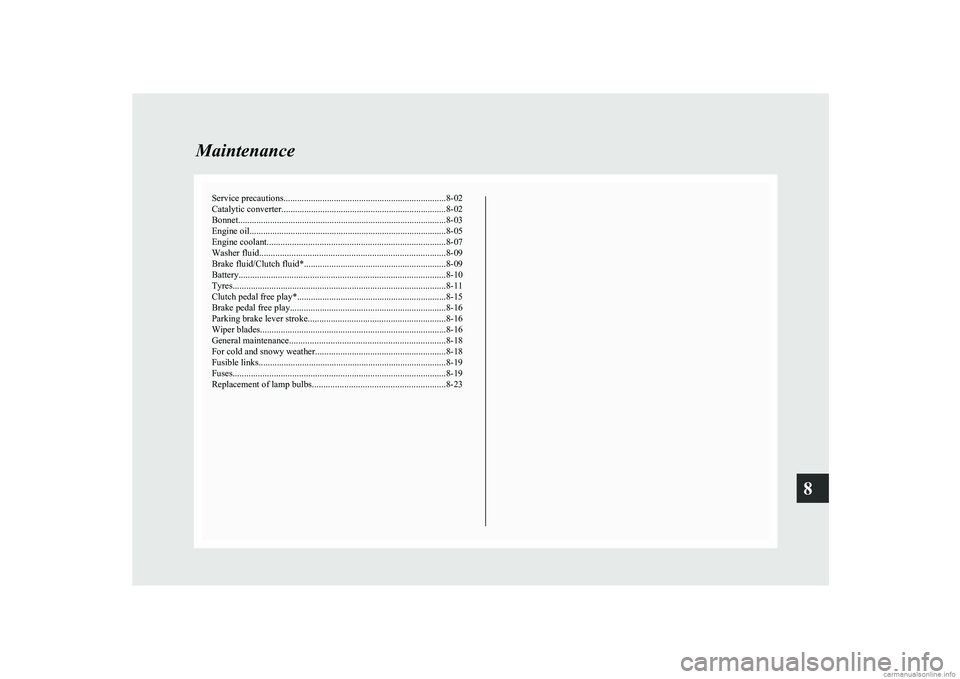
Service precautions....................................................................... 8-02
Catalytic converter ........................................................................ 8-02
Bonnet ........................................................................................... 8-03
Engine oil ...................................................................................... 8-05
Engine coolant .............................................................................. 8-07
Washer fluid ................................................................................. 8-09
Brake fluid/Clutch fluid* .............................................................. 8-09
Battery .......................................................................................... 8-10
Tyres ............................................................................................. 8-11
Clutch pedal free play* ................................................................. 8-15
Brake pedal free play .................................................................... 8-16
Parking brake lever stroke ............................................................ 8-16
Wiper blades ................................................................................. 8-16
General maintenance .................................................................... 8-18
For cold and snowy weather ......................................................... 8-18
Fusible links .................................................................................. 8-19
Fuses ............................................................................................. 8-19
Replacement of lamp bulbs .......................................................... 8-23Maintenance8
Page 216 of 274
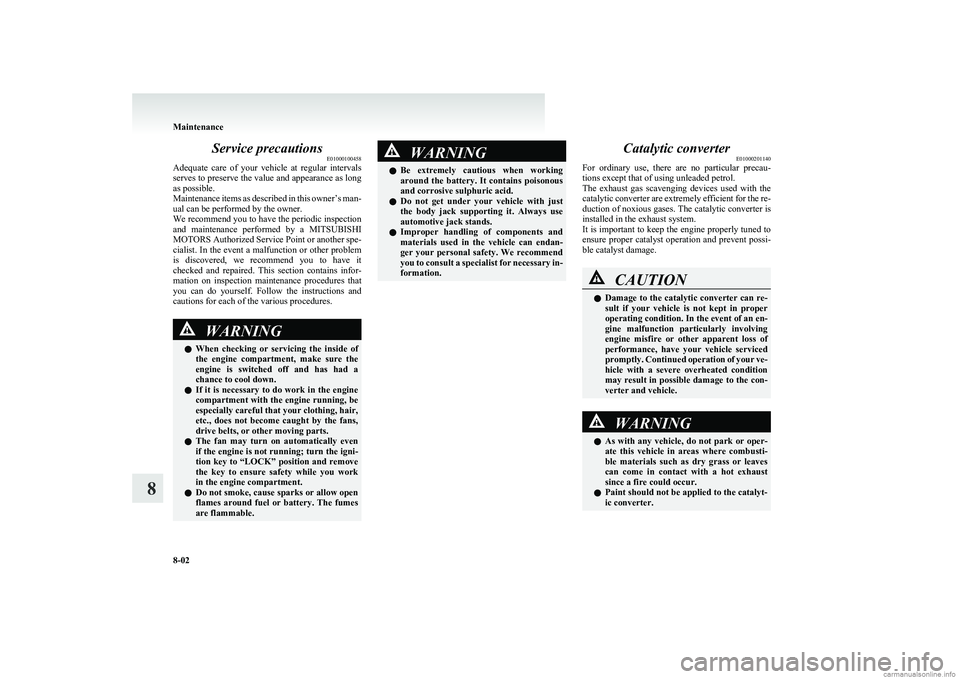
Service precautionsE01000100458
Adequate care of your vehicle at regular intervals
serves to preserve the value and appearance as long
as possible.
Maintenance items as described in this owner’s man-
ual can be performed by the owner.
We recommend you to have the periodic inspection
and maintenance performed by a MITSUBISHI
MOTORS Authorized Service Point or another spe-
cialist. In the event a malfunction or other problem
is discovered, we recommend you to have it
checked and repaired. This section contains infor-
mation on inspection maintenance procedures that
you can do yourself. Follow the instructions and
cautions for each of the various procedures.WARNINGl When checking or servicing the inside of
the engine compartment, make sure the
engine is switched off and has had a
chance to cool down.
l If it is necessary to do work in the engine
compartment with the engine running, be
especially careful that your clothing, hair,
etc., does not become caught by the fans,
drive belts, or other moving parts.
l The fan may turn on automatically even
if the engine is not running; turn the igni-
tion key to “LOCK” position and remove
the key to ensure safety while you work
in the engine compartment.
l Do not smoke, cause sparks or allow open
flames around fuel or battery. The fumes
are flammable.WARNINGl Be extremely cautious when working
around the battery. It contains poisonous
and corrosive sulphuric acid.
l Do not get under your vehicle with just
the body jack supporting it. Always use
automotive jack stands.
l Improper handling of components and
materials used in the vehicle can endan-
ger your personal safety. We recommend
you to consult a specialist for necessary in-
formation.Catalytic converter E01000201140
For ordinary use, there are no particular precau-
tions except that of using unleaded petrol.
The exhaust gas scavenging devices used with the
catalytic converter are extremely efficient for the re-
duction of noxious gases. The catalytic converter is
installed in the exhaust system.
It is important to keep the engine properly tuned to
ensure proper catalyst operation and prevent possi-
ble catalyst damage.CAUTIONl Damage to the catalytic converter can re-
sult if your vehicle is not kept in proper
operating condition. In the event of an en-
gine malfunction particularly involving
engine misfire or other apparent loss of
performance, have your vehicle serviced
promptly. Continued operation of your ve-
hicle with a severe overheated condition
may result in possible damage to the con-
verter and vehicle.WARNINGl As with any vehicle, do not park or oper-
ate this vehicle in areas where combusti-
ble materials such as dry grass or leaves
can come in contact with a hot exhaust
since a fire could occur.
l Paint should not be applied to the catalyt-
ic converter.
Maintenance
8-02
8
Page 217 of 274
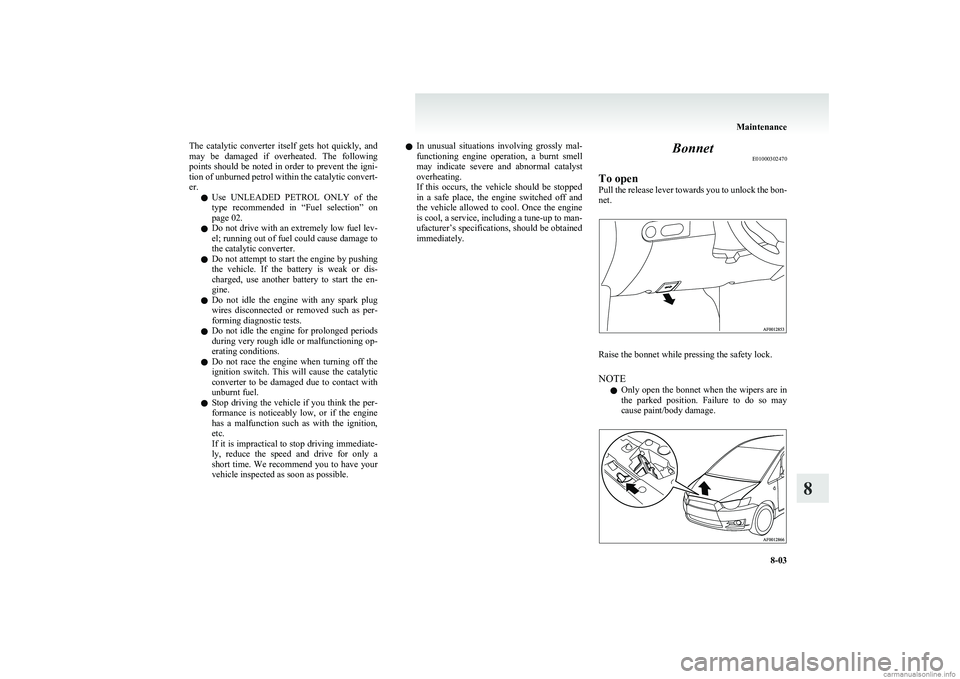
The catalytic converter itself gets hot quickly, and
may be damaged if overheated. The following
points should be noted in order to prevent the igni-
tion of unburned petrol within the catalytic convert-
er.
l Use UNLEADED PETROL ONLY of the
type recommended in “Fuel selection” on
page 02.
l Do not drive with an extremely low fuel lev-
el; running out of fuel could cause damage to
the catalytic converter.
l Do not attempt to start the engine by pushing
the vehicle. If the battery is weak or dis-
charged, use another battery to start the en-
gine.
l Do not idle the engine with any spark plug
wires disconnected or removed such as per-
forming diagnostic tests.
l Do not idle the engine for prolonged periods
during very rough idle or malfunctioning op-
erating conditions.
l Do not race the engine when turning off the
ignition switch. This will cause the catalytic
converter to be damaged due to contact with
unburnt fuel.
l Stop driving the vehicle if you think the per-
formance is noticeably low, or if the engine
has a malfunction such as with the ignition,
etc.
If it is impractical to stop driving immediate-
ly, reduce the speed and drive for only a
short time. We recommend you to have your
vehicle inspected as soon as possible.l In unusual situations involving grossly mal-
functioning engine operation, a burnt smell
may indicate severe and abnormal catalyst
overheating.
If this occurs, the vehicle should be stopped
in a safe place, the engine switched off and
the vehicle allowed to cool. Once the engine
is cool, a service, including a tune-up to man-
ufacturer’s specifications, should be obtained
immediately.Bonnet E01000302470
To open
Pull the release lever towards you to unlock the bon-
net.
Raise the bonnet while pressing the safety lock.
NOTE l Only open the bonnet when the wipers are in
the parked position. Failure to do so may
cause paint/body damage.
Maintenance
8-03
8
Page 219 of 274
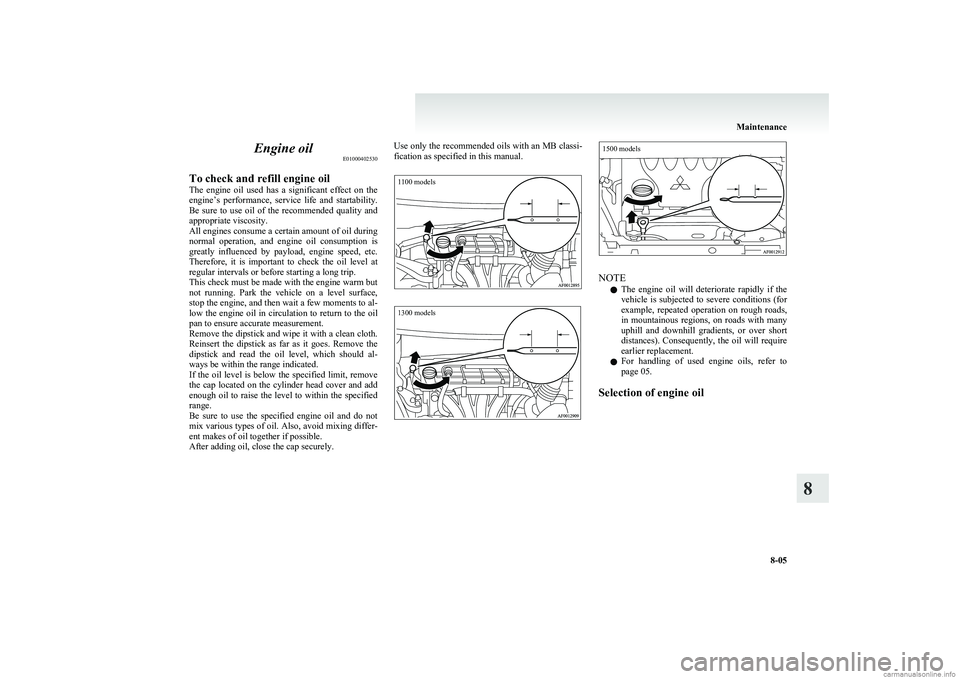
Engine oilE01000402530
To check and refill engine oil
The engine oil used has a significant effect on the
engine’s performance, service life and startability.
Be sure to use oil of the recommended quality and
appropriate viscosity.
All engines consume a certain amount of oil during
normal operation, and engine oil consumption is
greatly influenced by payload, engine speed, etc.
Therefore, it is important to check the oil level at
regular intervals or before starting a long trip.
This check must be made with the engine warm but
not running. Park the vehicle on a level surface,
stop the engine, and then wait a few moments to al-
low the engine oil in circulation to return to the oil
pan to ensure accurate measurement.
Remove the dipstick and wipe it with a clean cloth.
Reinsert the dipstick as far as it goes. Remove the
dipstick and read the oil level, which should al-
ways be within the range indicated.
If the oil level is below the specified limit, remove
the cap located on the cylinder head cover and add
enough oil to raise the level to within the specified
range.
Be sure to use the specified engine oil and do not
mix various types of oil. Also, avoid mixing differ-
ent makes of oil together if possible.
After adding oil, close the cap securely.
Use only the recommended oils with an MB classi-
fication as specified in this manual.1100 models1300 models1500 models
NOTE
l The engine oil will deteriorate rapidly if the
vehicle is subjected to severe conditions (for
example, repeated operation on rough roads,
in mountainous regions, on roads with many
uphill and downhill gradients, or over short
distances). Consequently, the oil will require
earlier replacement.
l For handling of used engine oils, refer to
page 05.
Selection of engine oil
Maintenance
8-05
8
Page 220 of 274
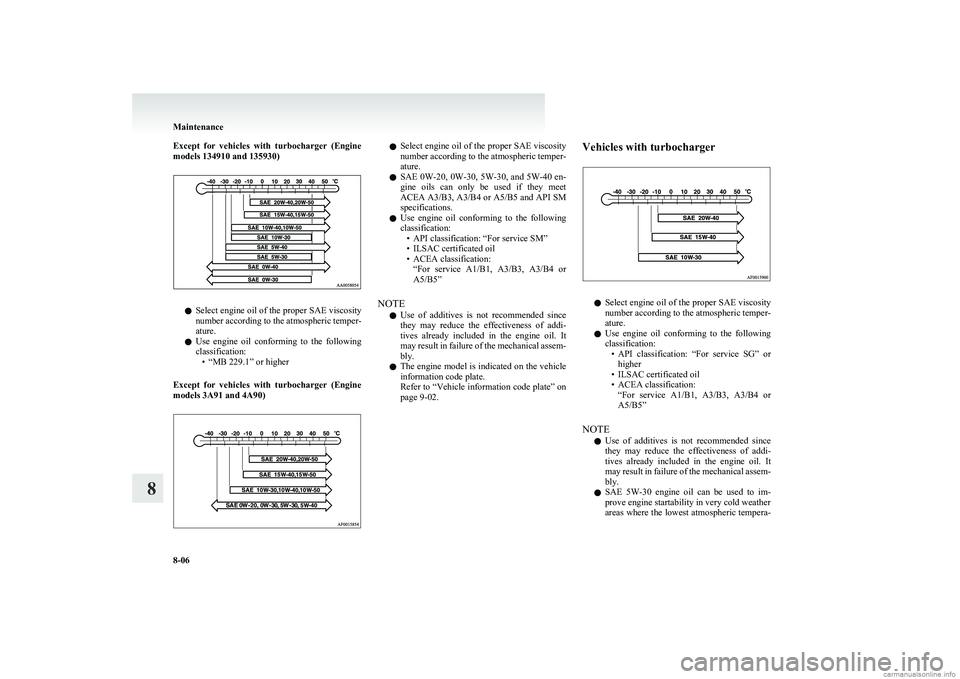
Except for vehicles with turbocharger (Engine
models 134910 and 135930)
l Select engine oil of the proper SAE viscosity
number according to the atmospheric temper-
ature.
l Use engine oil conforming to the following
classification: • “MB 229.1” or higher
Except for vehicles with turbocharger (Engine
models 3A91 and 4A90)
l Select engine oil of the proper SAE viscosity
number according to the atmospheric temper-
ature.
l SAE
0W-20 , 0W-30 , 5W-30 , and 5W-40 en-
gine oils can only be used if they meet
ACEA A3/B3, A3/B4 or A5/B5 and API SM
specifications.
l Use engine oil conforming to the following
classification: • API classification: “For service SM”
• ILSAC certificated oil
• ACEA classification: “For service A1/B1, A3/B3 , A3/B4 or
A5/B5”
NOTE l Use of additives is not recommended since
they may reduce the effectiveness of addi-
tives already included in the engine oil. It
may result in failure of the mechanical assem-
bly.
l The engine model is indicated on the vehicle
information code plate.
Refer to “Vehicle information code plate” on
page 9-02.Vehicles with turbocharger
l Select engine oil of the proper SAE viscosity
number according to the atmospheric temper-
ature.
l Use engine oil conforming to the following
classification: •API classification: “For service SG” or
higher
• ILSAC certificated oil
• ACEA classification: “For service A1/B1, A3/B3 , A3/B4 or
A5/B5”
NOTE l Use of additives is not recommended since
they may reduce the effectiveness of addi-
tives already included in the engine oil. It
may result in failure of the mechanical assem-
bly.
l SAE
5W-30 engine oil can be used to im-
prove engine startability in very cold weather
areas where the lowest atmospheric tempera-
Maintenance
8-06
8
Page 221 of 274
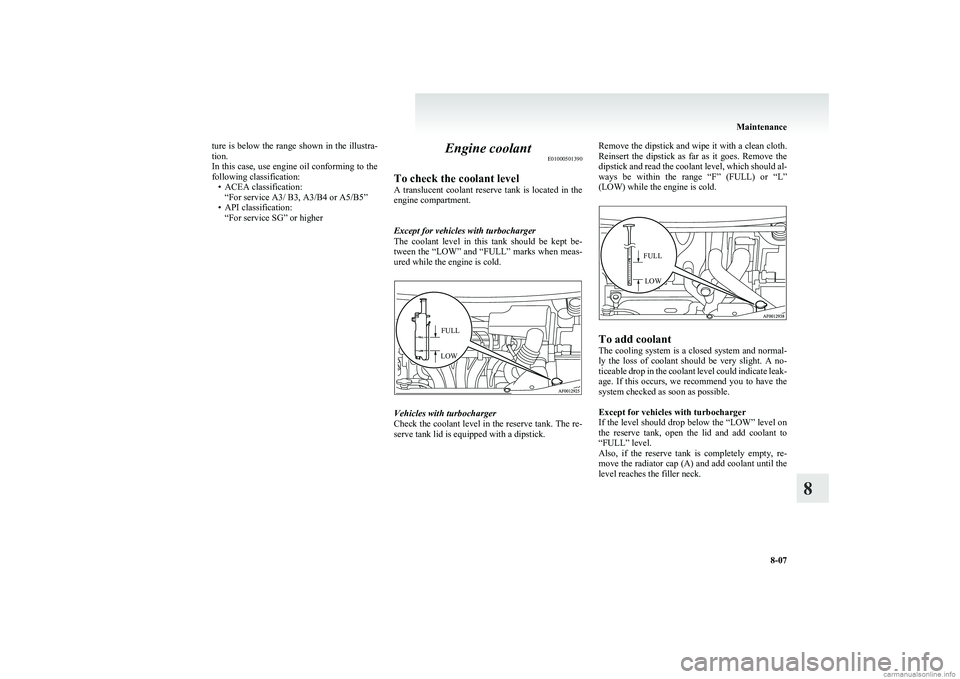
ture is below the range shown in the illustra-
tion.
In this case, use engine oil conforming to the
following classification: • ACEA classification:“For service A3/ B3, A3/B4 or A5/B5”
• API classification: “For service SG” or higherEngine coolant E01000501390
To check the coolant level
A translucent coolant reserve tank is located in the
engine compartment.
Except for vehicles with turbocharger
The coolant level in this tank should be kept be-
tween the “LOW” and “FULL” marks when meas-
ured while the engine is cold.
FULLLOW
Vehicles with turbocharger
Check the coolant level in the reserve tank. The re-
serve tank lid is equipped with a dipstick.
Remove the dipstick and wipe it with a clean cloth.
Reinsert the dipstick as far as it goes. Remove the
dipstick and read the coolant level, which should al-
ways be within the range “F” (FULL) or “L”
(LOW) while the engine is cold.FULLLOW
To add coolant
The cooling system is a closed system and normal-
ly the loss of coolant should be very slight. A no-
ticeable drop in the coolant level could indicate leak-
age. If this occurs, we recommend you to have the
system checked as soon as possible.
Except for vehicles with turbocharger
If the level should drop below the “LOW” level on
the reserve tank, open the lid and add coolant to
“FULL” level.
Also, if the reserve tank is completely empty, re-
move the radiator cap (A) and add coolant until the
level reaches the filler neck.
Maintenance
8-07
8
Page 222 of 274
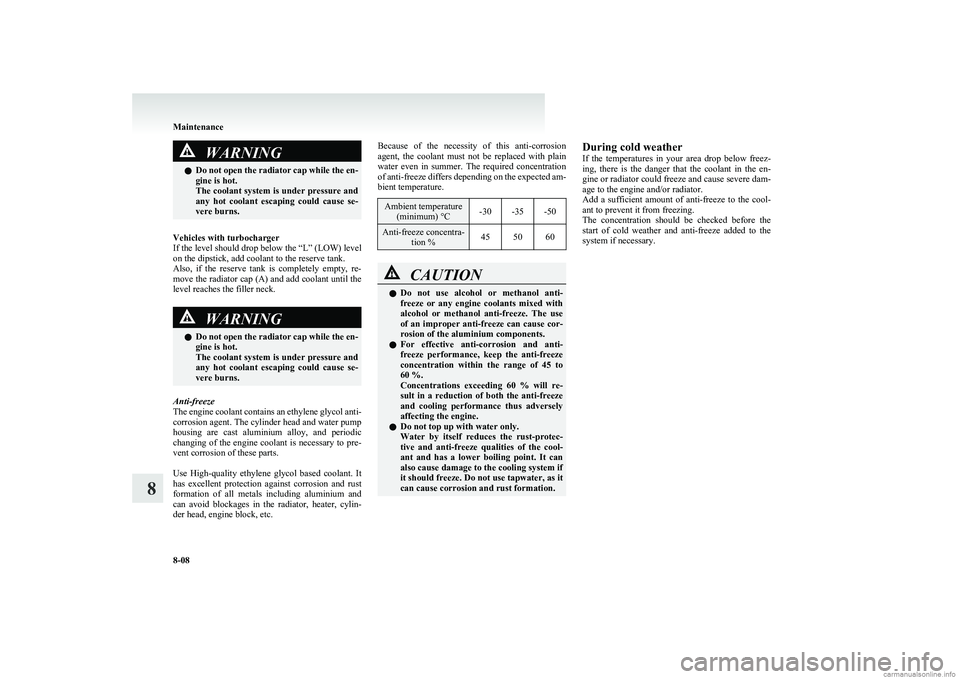
WARNINGlDo not open the radiator cap while the en-
gine is hot.
The coolant system is under pressure and
any hot coolant escaping could cause se-
vere burns.
Vehicles with turbocharger
If the level should drop below the “L” (LOW) level
on the dipstick, add coolant to the reserve tank.
Also, if the reserve tank is completely empty, re-
move the radiator cap (A) and add coolant until the
level reaches the filler neck.
WARNINGl Do not open the radiator cap while the en-
gine is hot.
The coolant system is under pressure and
any hot coolant escaping could cause se-
vere burns.
Anti-freeze
The engine coolant contains an ethylene glycol anti-
corrosion agent. The cylinder head and water pump
housing are cast aluminium alloy, and periodic
changing of the engine coolant is necessary to pre-
vent corrosion of these parts.
Use High-quality ethylene glycol based coolant. It
has excellent protection against corrosion and rust
formation of all metals including aluminium and
can avoid blockages in the radiator, heater, cylin-
der head, engine block, etc.
Because of the necessity of this anti-corrosion
agent, the coolant must not be replaced with plain
water even in summer. The required concentration
of anti-freeze differs depending on the expected am-
bient temperature.Ambient temperature (minimum) °C-30-35-50Anti-freeze concentra- tion %455060CAUTIONlDo not use alcohol or methanol anti-
freeze or any engine coolants mixed with
alcohol or methanol anti-freeze. The use
of an improper anti-freeze can cause cor-
rosion of the aluminium components.
l For effective anti-corrosion and anti-
freeze performance, keep the anti-freeze
concentration within the range of 45 to
60 %.
Concentrations exceeding 60 % will re-
sult in a reduction of both the anti-freeze
and cooling performance thus adversely
affecting the engine.
l Do not top up with water only.
Water by itself reduces the rust-protec-
tive and anti-freeze qualities of the cool-
ant and has a lower boiling point. It can
also cause damage to the cooling system if
it should freeze. Do not use tapwater, as it
can cause corrosion and rust formation.During cold weather
If the temperatures in your area drop below freez-
ing, there is the danger that the coolant in the en-
gine or radiator could freeze and cause severe dam-
age to the engine and/or radiator.
Add a sufficient amount of anti-freeze to the cool-
ant to prevent it from freezing.
The concentration should be checked before the
start of cold weather and anti-freeze added to the
system if necessary.
Maintenance
8-08
8
Page 224 of 274
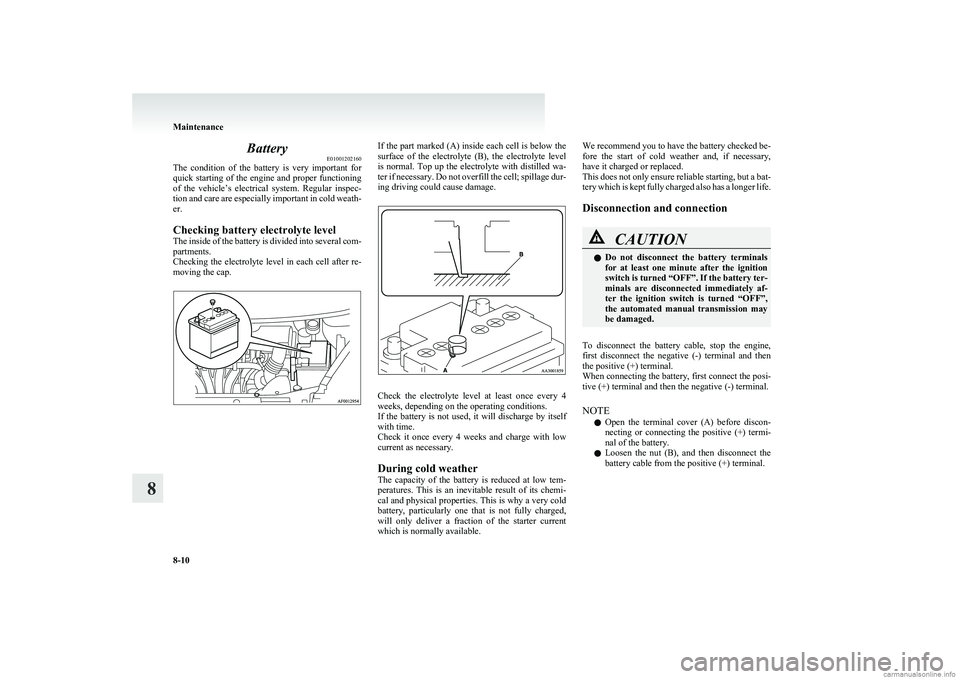
BatteryE01001202160
The condition of the battery is very important for
quick starting of the engine and proper functioning
of the vehicle’s electrical system. Regular inspec-
tion and care are especially important in cold weath-
er.
Checking battery electrolyte level
The inside of the battery is divided into several com-
partments.
Checking the electrolyte level in each cell after re-
moving the cap.If the part marked (A) inside each cell is below the
surface of the electrolyte (B), the electrolyte level
is normal. Top up the electrolyte with distilled wa-
ter if necessary. Do not overfill the cell; spillage dur-
ing driving could cause damage.
Check the electrolyte level at least once every 4
weeks, depending on the operating conditions.
If the battery is not used, it will discharge by itself
with time.
Check it once every 4 weeks and charge with low
current as necessary.
During cold weather
The capacity of the battery is reduced at low tem-
peratures. This is an inevitable result of its chemi-
cal and physical properties. This is why a very cold
battery, particularly one that is not fully charged,
will only deliver a fraction of the starter current
which is normally available.
We recommend you to have the battery checked be-
fore the start of cold weather and, if necessary,
have it charged or replaced.
This does not only ensure reliable starting, but a bat-
tery which is kept fully charged also has a longer life.
Disconnection and connectionCAUTIONl Do not disconnect the battery terminals
for at least one minute after the ignition
switch is turned “OFF”. If the battery ter-
minals are disconnected immediately af-
ter the ignition switch is turned “OFF”,
the automated manual transmission may
be damaged.
To disconnect the battery cable, stop the engine,
first disconnect the negative (-) terminal and then
the positive (+) terminal.
When connecting the battery, first connect the posi-
tive (+) terminal and then the negative (-) terminal.
NOTE l Open the terminal cover (A) before discon-
necting or connecting the positive (+) termi-
nal of the battery.
l Loosen the nut (B), and then disconnect the
battery cable from the positive (+) terminal.
Maintenance
8-10
8
Page 230 of 274
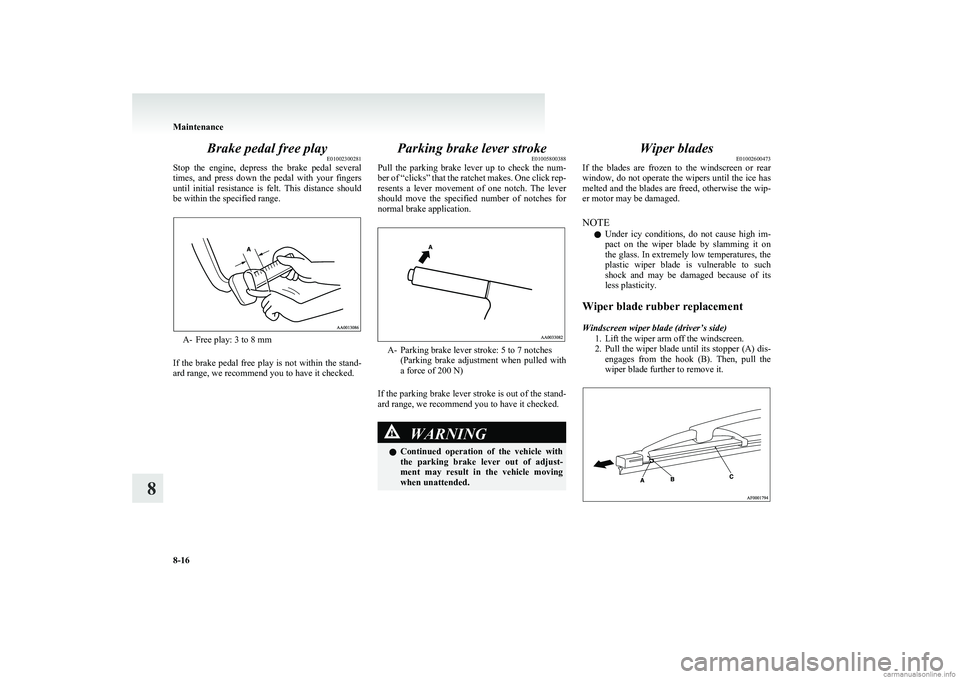
Brake pedal free playE01002300281
Stop the engine, depress the brake pedal several
times, and press down the pedal with your fingers
until initial resistance is felt. This distance should
be within the specified range.
A- Free play: 3 to 8 mm
If the brake pedal free play is not within the stand-
ard range, we recommend you to have it checked.
Parking brake lever stroke E01005800388
Pull the parking brake lever up to check the num-
ber of “clicks” that the ratchet makes. One click rep-
resents a lever movement of one notch. The lever
should move the specified number of notches for
normal brake application.
A- Parking brake lever stroke: 5 to 7 notches (Parking brake adjustment when pulled with
a force of 200 N)
If the parking brake lever stroke is out of the stand-
ard range, we recommend you to have it checked.
WARNINGl Continued operation of the vehicle with
the parking brake lever out of adjust-
ment may result in the vehicle moving
when unattended.Wiper blades E01002600473
If the blades are frozen to the windscreen or rear
window, do not operate the wipers until the ice has
melted and the blades are freed, otherwise the wip-
er motor may be damaged.
NOTE l Under icy conditions, do not cause high im-
pact on the wiper blade by slamming it on
the glass. In extremely low temperatures, the
plastic wiper blade is vulnerable to such
shock and may be damaged because of its
less plasticity.
Wiper blade rubber replacement
Windscreen wiper blade (driver’s side) 1. Lift the wiper arm off the windscreen.
2. Pull the wiper blade until its stopper (A) dis-
engages from the hook (B). Then, pull the
wiper blade further to remove it.
Maintenance
8-16
8